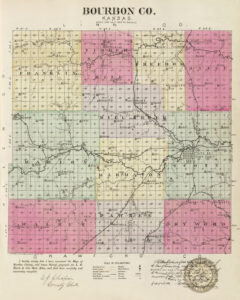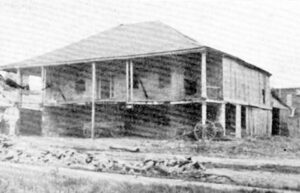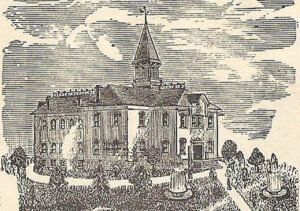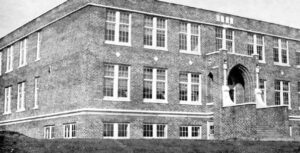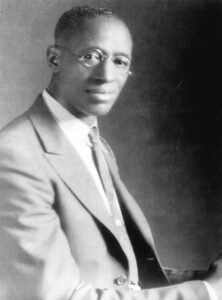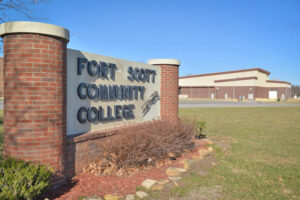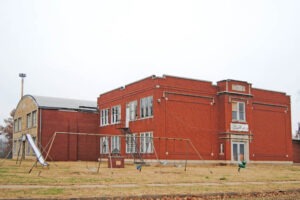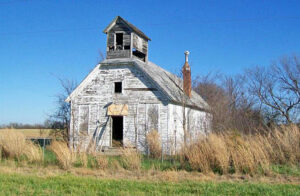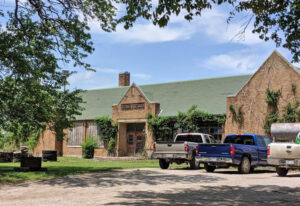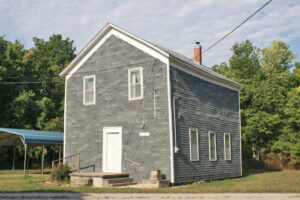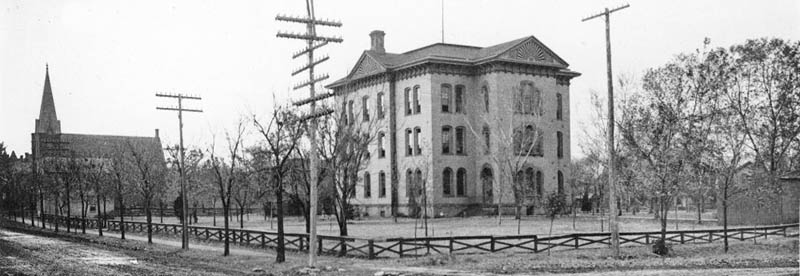
Central School in Fort Scott, Kansas, about 1890.
The first schools in Bourbon County, Kansas, were private ones at Fort Scott, which opened in 1857.
The first school district organized in Bourbon County was what became District No. 10 on December 10, 1859. This was the only one organized that year. In 1860, four districts were organized. That year, S.W. Greer, Superintendent of Schools, reported on the condition of the schools in the Territory. His figures for Bourbon County stated that there were seven organized districts, with 74 students attending each.
Eight districts were organized in 1862, at which time the county had 722 scholars; in 1865, there were 3,261. Twenty-three districts were organized in 1863, and eight in 1864.
Fort Scott City Schools District No. 55, in Bourbon County, Kansas, was organized in 1865 with Honorable P.P. Elder, an Indian agent, as president of the board of education, Honorable C.F. Drake, who became the president of the Bank of Fort Scott, as clerk, and “Uncle Billy” Smith, as he was familiarly known, as treasurer. At that time, including Government troops and refugees, there were about 25,000 people in the town.
The first school opened in the fall of 1865, and rooms for school purposes were fitted up in one of the old Government buildings on the plaza and the old courthouse on the corner of National Avenue and Second Street. Mr. Remsburg was the first principal, employed at a salary of $60 per month. The money for school support was from Government funds, and no direct assessment was levied.
At the close of 1865, there were 3,261 children of school age in the county. Many of these were children of refugees who had come to Fort Scott from Missouri and Arkansas. Through the efforts of C. F. Drake and a few others, school rooms were furnished and fitted up in the old hospital building and the old City Hall.
The few school buildings in the county were poorly furnished, the appliances were meager, and there was nothing like uniformity in books. The children brought books that had been used by their parents 15 to 20 years earlier, and they represented nearly as many different states and types of books as there were children.
In 1869, the only school in town was located in one of four rooms in the Government building, under Mr. Craven’s principalship. The following year, 1870, in addition to this school in the Government building, henceforth known as the Plaza school, four one-room ward schools were established in different parts of the city. Colonel T. W. McKinnie was elected superintendent, with some teaching to do, and the schools began to keep pace with the forward march of civilization under his administration.
During 1869 and 1870, the Central School, a large 12-room brick building, was erected on the square bounded by National Avenue, Fourth Street, Fifth Street, and Judson Street for $65,000. The building was considered the first modern grade school in Fort Scott.
In 1873, Superintendent McKinnie was succeeded by R.B. Dilworth. The new four-room building, known as the Margrave school, was first occupied in the fall of this same year. Mr. Dilworth formulated the first course of study and, although superintendent for only one year, gave the schools an impetus that has been an inspiration for years.
Superintendent Hutchinson followed Mr. Dilworth and remained in charge of the schools from 1874 to 1875 and from 1875 to 1876. In the two years following, 1876-77 and 1878-78, Superintendents Philo and Phales, respectively, were in charge. In September 1878, B. Hudson, a prominent attorney who later became the chairman of the city’s metropolitan police commission, was elected superintendent and served for seven years. Three additional brick buildings were erected during his superintendency: the Eddy School, the Wilson School, and the Plaza School. The latter was used for colored students only and supplanted the old stone Government building. Charles Demoisey succeeded Mr. Hudson in 1885 and remained in charge of the schools for two years.
In 1867, the organization of new school districts began again. From 1878 to 1881, except in 1878, one to nine school districts were organized each year.
In 1870, the county had 5,312 students.
In 1882, the student population was 7,866 males, 3,995 females, and 3,871. The number of pupils enrolled was 2,921 males and 3,089 females. The number of different teachers employed during the year was 150. The average wages for males were $34.27, and for females, they were $30.86. There are 100 schoolhouses in the county: two are brick, three are stone, and ninety-five are frame. In the district school libraries, there were 350 volumes. The value of school property in the county is estimated at $89,672, and the total value of all school property in the county is $100,000.
In 1880, the county had 7,015 scholars. By that time, there were 98 school districts in the county, including Fort Scott.
In 1888, Fort Scott, Kansas, grew to a population of 15,000 and became a first-class city; as a result, the tax levy for school purposes was reduced. The following year, the revenue was so reduced that Mr. Bemiss, to the regret of everybody, resigned to accept the superintendency of the schools at Spokane Falls, Washington, and became known as one of the best superintendents west of the Rocky Mountains.
Reverend Henry C. Bosley followed Superintendent Bemiss and began work in the fall of 1889. He was a graduate of the University of Rochester and a seasoned professional. Still, at the time he took charge of the Fort Scott schools, he was in very poor health, and after a long and heroic battle with that dread disease consumption, he died on February 27, 1890.
Guy P. Benton, educated at Ohio Wesleyan University in Delaware, Ohio, who was principal of the high school at the time of Mr. Bosley’s death, succeeded the latter.
In the early 1890s, the board owned eight buildings, and three rented ones were used for school purposes. The estimated value of school buildings was $110,000, and the bonded indebtedness was $60,000. The 1892 census showed 4,317 children of school age and an enrollment of 2,603. Forty-four teachers were employed in the schools, four working exclusively in the high school.
The course of study in the grades was eight years in length, and three years in high school; a diploma from the latter was required to be admitted to the State University without examination.
Any teacher passing the teachers’ examination with a minimum grade of 70% in any one branch and an average of 90% or above in all branches was granted a first-grade certificate, which was valid for life in the city of Fort Scott.
Fort Scott Normal College
Fort Scott Normal College was organized in September 1878. It was an incorporated institution that conferred degrees upon its graduates. The school’s purpose was to offer young men and women the opportunity to pursue any studies they wished and enter at any time.
The methods of instruction were the best. The school proposed staying up to date. Students had a good library for reference, school work, and general reading. The expenses were very low. Tuition was $10 for ten weeks. Good board and rooms could be secured for $2 a week. The school closed in 1899.
Mercy School of Nursing opened its doors in 1914 under the guidance of the Sisters of Mercy and continued to operate as a successful educational facility until 1975. It was the first school of nursing in Southeast Kansas to train black students as nurses. The former school, at 810 S. Burke, now houses the Fort Scott Community College School of Nursing and other programs.
Hawkins School
Between 1865 and 1955, four African American schools were located on or adjacent to land that now comprises Fort Scott National Historic Site. The last of the four, the 2nd Plaza School, was a consolidated school for all African American students in Fort Scott, serving grades 1 through 9, and was located at 111 Hendricks Street. This school was part of a continuum of African American education that began with the Civil War and ended with school integration in 1954. To honor Professor Ernest Hawkins, who served here for many years, the school was renamed the Hawkins School in 1946.
Classes at the Hawkins School included mathematics, art, English, social studies, and music. There was also an Industrial Arts Department for boys and a Home Economics Department for girls. All of the teachers and principals were African Americans. The Hawkins School was closed in 1956 when the Fort Scott public schools were integrated.
Professor Ernest Hawkins was born in Fort Scott in 1875 and devoted his life to educating African Americans. He was part of Fort Scott’s African American schools for 65 years, first as a student, then as a teacher, and later as principal. Professor Hawkins encouraged his students to “look sharp, be sharp, be somebody.”
Prominent Americans who attended Fort Scott’s African American schools included George Washington Carver and Gordon Parks. Born a slave, Carver gained renown as an artist, educator, chemist, agronomist, and botanist. Parks, an author, composer, photographer, and poet, was acclaimed Kansan of the Year in 1985 and received the National Medal of Arts in 1988. Carver attended the Fort Scott Colored School in 1878-79; Parks attended the 2nd Plaza School in the 1920s.
The Hawkins School was closed in 1956 when the Fort Scott public schools were integrated.
Fort Scott Community College
Established in 1919, Fort Scott Community College is the oldest public community college in the state of Kansas. The first graduating class, in 1921, had only two members. Originally, Fort Scott Junior College shared the Fort Scott High School building and operated as an extension of the high school program for 11th- and 12th-grade students in public education.
After Bourbon County voters approved a general-obligation bond issue to purchase the land and construct the first two buildings, about 200 students moved to the present 150-acre campus in October 1967. Some federal funds also paid part of the original $1.2 million cost. In 1967, the college also began offering courses in Paola.
The Administration Building was added in 1973. This building features administrative offices, meeting rooms, a cafeteria, a college bookstore, classrooms, and an adjacent dormitory. In 2010, the building was renamed the Dick Hedges Administration Building.
In 1982, the college completed the 38,500-square-foot Arnold Arena. The arena serves agricultural, business, sports, community, state, and regional organizations. One side consists of a rodeo arena with an earth floor, and the other half contains a basketball gym, weight training area, athletic dressing rooms, classrooms, a computer lab, and athletic offices.
In 1986, the college acquired the Pittsburg School of Beauty from Pittsburg State University.
In 2004, FSCC purchased the Sisters of Mercy Convent upon its closing. The college renovated the space for community rooms and the nursing program. The same year, the college remodeled a wing of the former Miami County Hospital at 501 S. Hospital Drive in Paola, which became the Miami County Campus. This expansion nearly doubled the size of the campus in Paola and created more opportunities for programs in the northern tier.
In 2009, Fort Scott Community College opened the new Danny and Willa Ellis Family Fine Arts Center. This building features a 600-seat theatre, community meeting rooms, the Gordon Parks Center for Culture and Diversity, and the Kathy Ellis Academic Hall, which houses departments such as art, band, choir, speech, and theatre.
The college is at 2108 South Horton Street in Fort Scott, Kansas.
Today, there are two school districts based in Bourbon County. Fort Scott USD 234 is headquartered in Fort Scott, Kansas. The district includes the communities of Fort Scott, Fulton, Devon, Garland, Hammond, Pawnee Station, and surrounding rural areas. The Uniontown USD 235 district is headquartered in Uniontown and includes the communities of Uniontown, Bronson, Hiattville, Mapleton, Redfield, and surrounding rural areas.
Historic Schools of Bourbon County
| Name | District | Years of Operation | Location & Information |
| Eugene Ware Elementary School | 234 | 1935-?? |
The school is a Colonial Revival-style brick building with one- and two-story sections, centered around a central two-story gymnasium and auditorium. It was a Public Works Administration project. It was listed on the National Register of Historic Places in June 2005. It is located at 900 E 3rd Street in Fort Scott, Kansas.
|
| Fort Lincoln School | 1864-1943 |
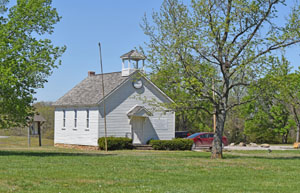 Fort Lincoln School in Fort Scott, Kansas by Kathy Alexander. The Fort Lincoln Schoolhouse was built in 1864 and moved to the northeast corner of the Fort Scott Community College campus in June 1975. Located at 18th and Horton Streets, this school first stood just south of the settlement of Fort Lincoln in northern Bourbon County. The fort, established by Union General James H. Lane on August 17, 1861, consisted primarily of a stockade, a blockhouse, and entrenchments. A settlement grew up around the fort and was connected with the pre-Civil War border conflicts. On March 23, 1863, area citizens organized Bourbon County School District No. 49. Even before a schoolhouse was built, the district hired Mary E. Metcalf as its first teacher for a three-month term, at a salary of $15 a month. The school board chose a building site on the south bank of the Little Osage River, on an acre of land deeded to the district by owner Lucy Hotchkiss. Construction was completed in 1864, and teacher D.B. Jackman was hired for a six-month term at $30 per month. The teachers changed every year for the first few years. In December 1880, the school board voted to move the schoolhouse to a new site three-quarters of a mile south. Another school was built a half-mile north and a mile east of Fort Lincoln. These changes eliminated the danger of students having to cross the river from the north to go to school and made it possible for students to walk no more than two miles to attend classes. The Fort Lincoln School’s new site was deeded to the district by owner Anna Warrington. |
|
| Fulton | 27 | 1917-1966 |
The Fulton High School and Grade School is comprised of three buildings. The 1917 school building of the Progressive Era is a two-story brick building. In 1936, a gymnasium and auditorium were attached to the north side of the brick school. This gymnasium, constructed as part of a Works Progress Administration project, features salvaged limestone from the demolition of an 1882 school building located at the same site. The third building on the site is a free-standing, one-story cafeteria that was constructed in 1964. The property functioned as a combined high school and grade school until 1966, when the high school consolidated with Fort Scott. The elementary school closed in 1978. The property was listed on the National Register of Historic Places in 2015. It is located at 408 W Osage St in Fulton, Kansas. |
| Guinn | 36 | 1895-1940s |
The Guinn School building’s construction date is estimated to be 1895, after School District #36 received ownership of the one-acre site in 1894. In 1945, the building was sold to the Drywood 4-H Club and served as a community center. Historic photos indicate that it functioned as a school through the 1940s. The rectangular wooden school frame, with its clapboard belfry tower, is in a state of deterioration. The interior has wood floors, beaded board wainscotting, and plaster walls. It is located at 599 US-69 Highway in Fort Scott, Kansas. |
| Redfield Grade School | ?? | 1938-?? |
The old Redfield Grade School is a one-story brick building designed in the Late 19th and 20th-century Classical Revival style, featuring a gable roof and parapet. Serving as a residence today, it is located at 101 W. 4th Street in Redfield, Kansas.
|
| Xenia | 1866-1880 |
The one-story old Xenia School is a two-story rectangular building built in the vernacular style, with a gable-front roof and a brick chimney on the west side. Both the exterior walls and the roof are covered with asphalt shingles. The Xenia Masons contributed to the construction of the school building so that they could meet on the second floor. A new school building was constructed east of the old school in 1880, but the Xenia Masons, chartered in 1866, continued to meet in the old school building and still hold monthly meetings today. The building contains many original furnishings. It is now called the Xenia Masonic Lodge No. 47 and is located north and east of K-65 Highway on 65th Street. |
©Kathy Alexander/Legends of Kansas, updated April 2025.
One-Room, Country, & Historic Schools of Kansas
Sources:
Cutler, William G.; History of Kansas; A. T. Andreas, Chicago, IL, 1883.
Fort Scott Community College
Fort Scott Tribune
Fort Scott Tribune and Fort Scott Monitor, September 25, 1895
Historic Marker Database
Kansas State Historical Society, The Columbian History of Education in Kansas, Hamilton Printing Company, Topeka, KS, 1893.
Robley, T.F.; History of Bourbon County, Kansas, Press of the Monitor Book & Print. Co., 1894.

